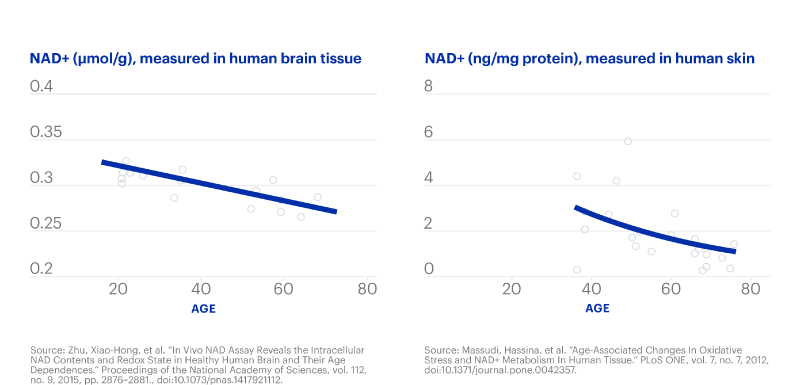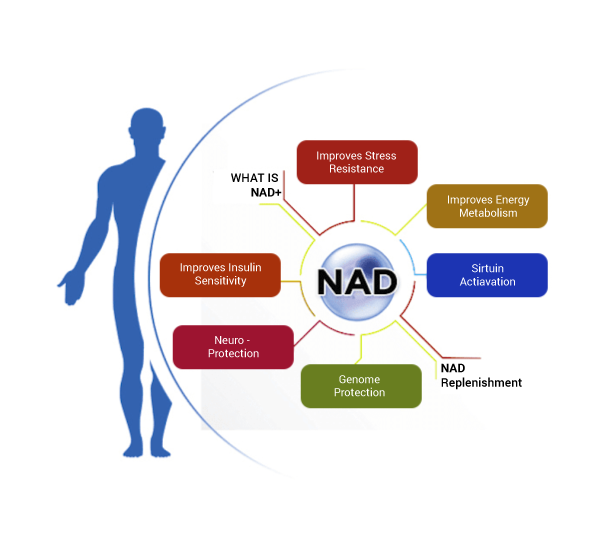What is NAD+?
NAD+ stands for Nicotinamide Adenine Dinucleotide. The compound is found in every cell in your body and plays a key role in maintaining our cell’s health and performance of their functions.
This is due to NAD+ contributing to our cells’ ability to transform the food we eat into cellular energy powering the healthy functions of our cells! These functions include boosting energy metabolism, repairing DNA, protecting cells from damage, promoting healthy brain and cardiovascular function, and reducing inflammation – overall being responsible for maintaining the health of your DNA and keeping you healthier for longer.
As you get older, your NAD+ levels naturally decline, meaning that our cells have less energy and become worse at maintaining their healthy functions. This causes your body to get old, your joints to ache, your energy to flag, and your brain to degenerate.
Nicotinamide Adenine Dinucleotide (NAD+) is a coenzyme present in every cell of your body and fuels over 400 metabolic reactions.
NAD+ is a naturally occurring compound that determines how quickly our cells age. Not only is it fundamental to the biological processes that make life possible, it plays a major role in oxidative metabolism and lifespan extension.
Our NAD+ levels naturally decline by more than 50 percent as we age, leading to cellular dysfunction and an inability for the body to repair DNA damage.
NAD in skin and brain
Nobel Prize-winning scientists discovered NAD+ more than 100 years ago.
Since 1906, the prized, “youth molecule” has been central to countless scientific showing that upregulating intracellular NAD+ is the key to increasing the amount of time we spend in good health.
In addition to regulating bioenergetics and maintaining mitochondrial health accumulating evidence has suggested that NAD+ is also involved in other biological activities such as antioxidation and oxidative stress, gene expression, immunological functions, aging and cell death.
William Young and Sir. Arthur Harden first discovered NAD+ in 1906 when trying to understand the fermentation process. This is when yeast metabolises sugar to create alcohol. It was not until 20 years later there was recognition for their work in fermentation. Harden shared the 1929 Nobel Prize for Chemistry with Hans von Euler-Chelpin. It was Euler-Chelpin who found NAD+ has a structure of two nucleotides and these are what forms DNA. The findings were an important breakthrough. It showed the metabolic process for fermentation relied on NAD+ and the vital role NAD+ has in the human metabolic process.
In the 1930s, Otto Heinrich Warburg did further research into the role NAD+ has and how the metabolic system functions. In 1931, the chemists Conrad A. Elvehjem and C.K. Koehn identified that nicotinic acid, a precursor to NAD+, was the mitigating factor in pellagra. This is a severe condition that ravaged 200,000 people in the America’s south in the late 1920s. United States Public Health doctor Joseph Goldberger identified the cause of this fatal disease was a lack of something lacking in people’s diet. And, discovered brewer’s yeast was a cheap cure to pellagra.
Goldberger died before the ultimate discovery that it was nicotinic acid, but his contributions led to the discovery, which also informed eventual legislation mandating the fortification of flours and rice on an international scale.
During the 1940s, biochemist Arthur Kornberg discovered the enzyme that creates NAD+. His research became the foundation for a better understanding of NAD+. In 1959 he won a Nobel Prize in Physiology or Medicine for discovering how DNA and RNA forms. In 1958 that scientists, Jack Preiss and Philip Handler, discovered how nicotinic acid becomes NAD+ using the same form of vitamin B3 used to help cure pellagra. Handler’s focus was on malnutrition and how it affects different diseases. His work helped scientists to further understand the importance of NAD+ to the diet. This work earned him a National Medal of Science for his contribution to biomedical research.
While scientists had now realized the importance of NAD+, they had yet to discover its intricate impact on a cellular level. Forthcoming technologies in scientific research combined with comprehensive recognition of the coenzyme’s importance ultimately encouraged scientists to continue studying the molecule.
For nearly 100 years, NAD+ has been incredibly important, but the gradual pace of scientific research and technological development has only now begun to reveal how it can be utilized.
Knowing the history of NAD+ and subsequent discoveries around the coenzyme has led researchers to explore what the science community can now do with the information. NAD+ has enormous potential and how it will be fulfilled is the most exciting aspect of current research.
A human study from 2017, conducted by Elysium HealthTM, found that daily doses of an NAD+ precursor (NAD+ Boosters) increased NAD+ levels by an average of 40 percent.
What is NMN?
NMN is an entirely natural compound found in our bodies. Various food sources also contain this compound in minuscule amounts. NMN is a direct and potent NAD+ supplement. Mice given an oral supplement of NMN showed increased liver NAD+ levels in just 10 minutes and showed an increase in muscle tissue by 30 minutes.
Increased NAD+ levels stimulate energy metabolism, DNA repair, and SIRTUIN activity. SIRTUINS are the longevity-genes shown to be active during caloric restriction and life-extension in many animal models.
NMN is more effective than other metabolites at restoring NAD+ levels inside of cells.
What are Sirtuins?
Sirtuins are a family of proteins that regulate cellular health. Sirtuins play a key role in regulating cellular homeostasis. Homeostasis involves keeping the cell in balance. However, sirtuins can only function in the presence of NAD+.
How NAD+ & NMN Can Help You?
Only recently have scientists confirmed this direct link between falling NAD+ levels and ageing in both animals and human subjects. A breakthrough study published by Harvard scientists in 2013 showed for the first time that some aspects of ageing might be reversible. After treating old mice with NAD+ boosters like NMN, several biometric markers that were subsequently measured resembled those of young mice: “the equivalent of a 60-year old converting to a 20-year old”.
A long-term evaluation of oral supplementation of NMN in mice was found to be effective at improving NAD+ levels safely. Mice supplemented with NMN vs. a control group showed notable age-associated differences in mass, energy metabolism, blood sugar, lipid metabolism, gene expression changes, mitochondrial oxygen use, eye function, bone density and immune function with no apparent toxic effects.
How do NAD boosters work?
The body converts NAD boosters such as nicotinamide riboside (NR) and nicotinamide mononucleotide (NMN) to NAD+ in one or two steps depending on the molecule. NAD levels control the activity of DNA repair enzymes and seven enzymes that defend against aging and disease called “sirtuins”.
Introducing EliX Health NMN
One product to support the long-term health of your cells.
Elix Health NMN is a daily supplement that is designed to increase cellular NAD+ levels and activate sirtuins (a family of genes that play a role in regulating cellular health, and can only function in the presence of NAD+).
NAD+ levels decline naturally as we age. NAD+ is required for vital cellular processes including cellular energy production and healthy DNA maintenance.
NMN is most effective at restoring intracellular NAD+










